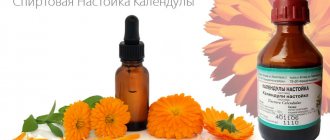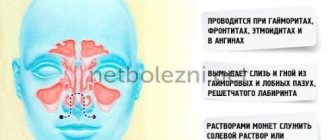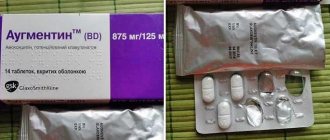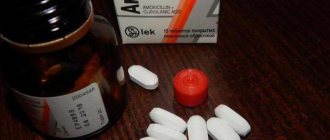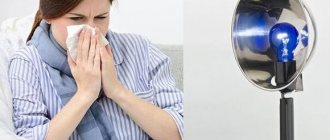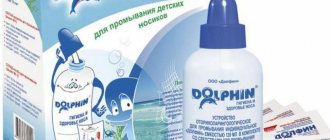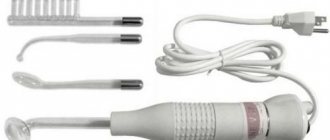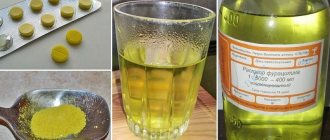Cleaning the maxillary sinuses at home should be done regularly, especially if you have frequent runny noses or physiological disorders of the nasal passages that prevent the natural outflow of mucus. When the sinuses are inflamed, home treatment fades into the background and becomes an auxiliary therapy, but doctors do not recommend completely abandoning such manipulations as rinsing and nasal instillations.
Competent complex therapy, combining the use of pharmacological drugs and traditional treatment methods, will shorten the duration of the disease and eliminate the threat of secondary infection.
Ways to rinse your sinuses
The easiest and safest way to rinse the maxillary sinuses at home is to inject nasal sprays made with sea water. Unlike ordinary saline solutions, pharmaceutical preparations contain a large complex of mineral compounds that have a beneficial effect on local immunity. This method of irrigating the nasal cavity is ideal for children, and adults, depending on the severity of the symptoms, can choose any other option for clearing the nose:
- Drawing the medicinal solution into the nose from a deep plate or cup. Pressing one nostril with a finger, the patient leans over a cup of solution, with the open nostrils slowly drawing in the liquid “all the way.” You need to do this 5-7 times with each nostril, then cough and blow your nose.
- Instillation using a pipette. Tilt your head first to one side, then to the other, insert 3-4 drops of the selected product into each nasal passage, then blow your nose thoroughly.
- Active rinsing. Fill a small syringe or neti pot with the product and, tilting your head to the side, inject all the liquid into the upper nostril in a continuous, drawn-out stream so that the spent medicine comes out through the other nasal passage.
- Inhalations. Inhale the steam by bending over a bowl of hot medicinal solution and covering your head with a towel.
An important condition for any manipulation of washing the maxillary sinuses at home is not to go outside, and also not to take a bath or use a hairdryer for at least 30 minutes after the procedure.
Effect of washing
Rinsing the nasal sinuses with medications reduces swelling of the mucous membrane, the capillary network returns to tone, and the epithelium cleared of mucus is easier to treat. Thanks to proper cleansing of the sinus cavity, the natural outflow of mucus is improved.
Rinsing the maxillary sinuses is easy to do at home and can be used not only by adults, but also by children.
Sinus cleansing is performed to achieve the following effects:
- Improved nasal breathing.
- Reduced swelling of the mucous membrane.
- Cleansing the maxillary sinus from a harmful agent.
- Removal of accumulated mucus.
- Restoration of the local immune response.
- Prevention of relapses in chronic course.
The procedure is unique in that it has no contraindications and can be used to treat patients of all ages. When washing the nose in young children, some difficulties may arise, but everything can be solved by using devices for children, taking into account their age category.
Rinsing the nose with saline solutions
How to cleanse the maxillary sinuses at home using the most budget-friendly method? Using ordinary table salt, which has a high disinfecting effect. To prepare the solution, take boiled warm water (200 ml) and dissolve a little, about a third of a teaspoon of coarse non-iodized salt in it. The crystals must be completely dissolved and the sediment drained.
Rinsing is carried out in any convenient way, but it is best to focus on your condition when choosing a method: at the initial stage of the disease, you can use drip irrigation of the sinuses, and in case of severe nasal congestion, use a Chinese teapot or a medicinal bulb. If severe dryness occurs in the nose after the procedure, the amount of salt when preparing the solution should be reduced or the rinsing should be replaced with a special salt inhalation.
For inhalation, take a linen or cotton napkin, soak it in a hot saline solution prepared in the manner already described, and place it on the face of the patient, who is lying in a relaxed state. The procedure takes 10 minutes, after which you need to wipe your face dry.
Salt rinses
The article describes how to rinse your nose with sinusitis, how to do it correctly, the advantages and disadvantages of basic solutions.
Washing plays a big role in alleviating the symptoms of inflammation of the maxillary sinus. It allows:
- cleanse the nasal cavity of mucus and pus accumulated there;
- quickly restore the functions of the respiratory epithelium;
- restore capillary tone and blood supply;
- improve the activity of the body’s protective immune reactions;
- restore physiological nasal breathing;
- improve the effectiveness of medications that can be applied topically after rinsing.
In a clinic setting, the procedure is performed with a special device under the supervision of an otolaryngologist. He may advise washing at home and give recommendations regarding individual solutions (both medicinal and natural).
It is contraindicated to rinse your nose under the following conditions:
- severe nasal congestion (risk of solution getting into the middle ear and developing acute otitis media);
- the patient's tendency to nosebleeds;
- curvature of the nasal septum (low effectiveness of the procedure);
- hypersensitivity to the rinsing solution;
- recent traumatic injury to the nose;
- the presence of neoplasms in the nasal cavity (polyps, tumors).
The disadvantage of the procedure is its ability to wash away the protein-fat film that is located on the surface of the respiratory epithelium, which makes it more vulnerable to pathogenic microorganisms. Therefore, before rinsing, you should definitely consult a qualified doctor.
The procedure must be carried out over a sink. For the procedure, you can use a syringe, a regular syringe, a sinus catheter or a special “teapot”. The solution should be warmed to body temperature (36-37°C). Below are step-by-step instructions for rinsing your nose:
- The patient stands over the sink and tilts his torso with his head at an angle of 90°.
- He turns his head to the side so that the nasal passages are in a vertical line.
- The tip of the instrument with the solution is carefully inserted into the upper nasal passage so as not to injure the mucous membrane.
- The patient breathes smoothly through his mouth.
- Next, he slowly releases the solution from a syringe or other device.
- If the procedure is performed correctly, the liquid flows along the back wall of the nasopharynx, and then enters the lower nasal passages and flows out of the opposite nostril.
- The position of the head changes to rinse the other nasal passage.
- After the procedure is completed, the patient blows his nose, removing any remaining solution, mucus, pus and blood.
Usually, during the first attempts, the patient’s rinsing liquid flows not only from the nose, but also enters the mouth. This is not something to be afraid of. With due diligence, after just a few attempts the patient manages to do everything correctly. After the procedure, you must refrain from going outside for an hour.
Helpful: Increased testosterone in women
Saline solution and preparations based on it are the most recognized and frequently used means for rinsing the sinuses at home. A weakly concentrated solution is suitable for use for preventive purposes, a concentrated solution is suitable for removing pus from the maxillary sinuses.
Types of saline solutions:
- Saline solution. An affordable product that contains a physiological concentration of salt. It thins mucus, soaks crusts, and washes away bacteria and viruses.
- Saline solution. You need to take sea salt. For preventive use, dilute one teaspoon of salt per 1 liter of water; to cleanse the maxillary sinuses of pus, dilute a level teaspoon of salt per glass of water. Sea salt has a number of beneficial properties that help cope with inflammation in the sinuses.
- Drops and sprays. There are many drops for rinsing the sinuses, from which you can choose the appropriate product, taking into account your financial capabilities.
To flush the sinuses from mucus, viruses, and prevent colds, you can use isotonic solutions (0.6–0.9%):
- Salin;
- Rinolux;
- No-salt;
- Humer isotonic;
- Otrivin Baby. Otrivin Baby and Humer are perfect for even the youngest patients.
To clean the sinuses from purulent contents, eliminate nasal congestion and swelling, it is necessary to use hypertonic solutions with a salt concentration of up to 2.6%:
- Kwix is a sales leader;
- Aqua Maris is a bestseller;
- Aqualor - there are several varieties of the drug, each selected according to the nature of the discharge;
- Humer is hypertensive;
- Dolphin, in addition to a unique complex of minerals, contains extracts of medicinal plants.
Saline solutions are widely used in cleaning the nasal cavities, but they can also be useful in removing contents from the paranasal sinuses.
Their action in this case will be based on the hygroscopic properties of salt - its ability to absorb and “pull out” any liquid fractions.
The liquid itself, of course, will practically not get into the sinus, but it will create specific chemical and physical conditions that enhance the removal of mucus.
You can use any salt solutions:
- Isotonic sodium chloride solution, or saline solution (9 grams of table salt per 1 liter of water)
- Dry sea salt solution (1 tablespoon per 1 liter of water)
- Concentrated saline solution (2 tablespoons of table salt per 0.5 liter of water)
- Ready-made salt mixtures purchased in pharmacies, etc.
Sinus cleansing with vegetable juices
How to clear the maxillary sinuses at home? If you are not allergic to vegetable juices, you can use fresh beet or carrot juices, strained through 6 layers of gauze. The finished juice, using a pipette, is injected into each nostril, 3-4 drops, and then blown out along with the mucus.
There are other recipes for homemade nasal preparations with natural vegetable juices:
- Soak a gauze knot with fresh onion juice and massage the bridge of the nose and sinuses with it.
- Dilute 50 ml of beet juice in 100 ml of saline, add 0.5 teaspoon of liquid honey, rinse your nose with this product from a syringe.
- Combine 1 teaspoon of potato juice with 1 teaspoon of red onion juice, add a drop of honey to the mixture, and apply this solution to your nose 3-4 times a day. If the medicine is prepared for a child, then the composition is supplemented with a quarter teaspoon of vegetable oil.
If, after using vegetable mixtures, itching or burning is felt in the nasal cavity, you need to soak a cotton pad with vegetable oil and treat the inner surface of the nose.
Intensive rinsing
The essence of this technique is to deliver a large amount of medicinal substances into the nasal cavity and nasopharynx in the hope that at least some of them will penetrate into the sinuses.
Take a rubber bulb-syringe and fill it with antiseptic liquid. It can be:
- infusions of chamomile, St. John's wort or calendula;
- saline solutions;
- furatsilin;
- purchased medications, for example, chlorophyllipt, etc.
Then insert the tip of the syringe into the nostril and squeeze the bulb tightly. The stream of solution should penetrate deep into the nasal cavity.
This procedure is not recommended for children, since fluid under pressure can enter the inner ear and cause otitis media, and in addition, it can itself damage the nasal mucosa.
Propolis against sinusitis
Before you clean the maxillary sinuses at home with either propolis or other bee products, you should make sure that the patient is not allergic to them. The occurrence of an allergic reaction such as swelling of the nasal mucosa will lead to a deterioration in the patient’s condition; this may negate the effect of the previous stage of treatment
To treat maxillary sinuses at home, alcohol and water tinctures of propolis are used:
- Pour 1.5 tbsp. spoons of crushed propolis ½ cup of medical alcohol, put the mixture in a dark place for 7 days. Dilute the strained infusion 1:1 with sea buckthorn oil, use it for instillation 2 times a day.
- Dilute 1.5 tbsp. spoons of finely grated propolis with a quarter cup of boiling water, leave the solution for 24 hours, strain. An aqueous solution can be instilled into the nose 3-4 times a day.
Alternative medicine specialists recommend drinking a course of propolis oil to prevent sinusitis or during treatment. To prepare it, you need to mix a tablespoon of crushed propolis with hot, melted butter (80 g). The mixture is heated until slight signs of boiling appear and, with continuous stirring, simmer for another 10 minutes. The hot mass is ground until completely homogeneous, then taken orally 1 teaspoon an hour before main meals.
St. John's wort for sinusitis at the initial stage
How to clean the maxillary sinuses at home, enhancing the effect of the antibiotic prescribed by the doctor or stopping the development of the disease at the very beginning? Naturopaths advise at the first signs of sinusitis to rinse your nose with a decoction of St. John's wort, prepared by brewing 5 g of dry herb with a glass of boiling water. After cooling and straining, the broth is poured into a neti pot and the rinsing procedure is performed.
The same infusion can be used orally, half a glass 3 times a day for two weeks. It should be noted that this method of treatment is suitable only when sinusitis has not yet reached the purulent stage.
Treatment of Kalanchoe
Treatment of sinusitis with Kalanchoe juice has one drawback - the effect of the procedures does not last long and is of an emergency nature when it is necessary to urgently remove pus and mucus from the nasal cavity. The finished juice can be stored in the refrigerator for no more than 5 days, and the alcohol tincture for rinsing can be stored for about a month.
To prepare juice, several large leaves are cut from a healthy plant, kept in the refrigerator for several days, wrapped in thick paper, and then pureed in a mortar. The resulting grounds are filtered through 6 layers of gauze, the juice is poured into a glass container, where it should sit for about a day until large particles settle to the bottom. After the required time, you can use the juice by putting 1-2 drops into your nose several times a day.
How to rinse the maxillary sinuses at home using Kalanchoe? Take 7 fleshy leaves of the plant, pound them in a mortar until a paste is obtained and pour a glass of medical alcohol. Within 10 days, the tincture should ferment in a warm place, after which it can be used for regular washing, after diluting it with boiled water 1:20.
Warming up and compresses
Washing and other methods of getting rid of pathological secretions work best after thoroughly warming the sinuses. The easiest way to clean the maxillary sinuses at home using dry heating is to apply a linen bag filled with table or sea salt calcined in a frying pan to the bridge of the nose.
Immediately after warming up, you can start rinsing or make an application, which should be left on for at least 6 hours. In this case, a honey compress prepared in this way has proven itself to be excellent:
- heat 1 tbsp in a water bath. a spoonful of honey;
- mix honey with egg yolk;
- With continuous kneading, add rye flour to the mixture until you get a dense, non-spreading mass.
A flat cake is formed from the warm dough and applied to the problem area. A piece of cellophane is placed on top of the honey compress, and gauze rolled into 6-8 layers is placed on top of the cellophane. The bandage is fixed with adhesive tape.
Inhalations with herbs
This is one of the indirect ways to clear the sinuses. But it will be effective only if all mucus is first removed from the nasal passages and the sinus openings are open.
To prepare the infusion, mix 2 tablespoons of dry chamomile, sage, eucalyptus, St. John's wort and lavender, as well as 1 tablespoon each of noble yarrow and string.
Take 3 tablespoons of the resulting mixture, place in an enamel or glass bowl and pour in 2 liters of boiling water. Close the dish with a lid, wrap it in a large towel and let it sit for 15 minutes. Then cover your head with a towel, lean over the container and inhale the vapors of the herbal infusion through your nose.
In addition, you can also inhale the vapors of calendula tincture, a few drops of which should be dissolved in boiling water. During such procedures, vapors of medicinal herbs will penetrate the nose and further into the paranasal sinuses. Cooling, the steam condenses on the inner surface of the sinuses and dilutes mucus and pus, ensuring easier and simpler removal through the anastomosis.
The effect of this procedure when rinsing the sinuses at home is based on the effect of the volatile components of propolis, which can penetrate the sinuses. You will need 2 teaspoons of propolis solution in alcohol, which is sold in pharmacies. Pour them into 2 liters of boiling water, and then immediately cover your head with a towel, lean over the pan and inhale the vapors. Another way to inhale propolis is to soak cotton swabs with its ointment, which should then be inserted into both nostrils for 5 minutes.
Remember that it is better not to use this method in young children, since almost all beekeeping products have an increased allergenic effect and can provoke unwanted reactions from the child’s physiologically immature immune system.
Blitz of recipes for sinusitis
Below are a few more effective options for clearing your maxillary sinuses at home:
- dissolve 1 mummy tablet in 1/2 cup of warm boiled water, instill this solution into your nose 4-6 times a day;
- Brew 5 g of dried calendula flowers with 200 ml of boiling water, leave the mixture until it cools, strain, rinse the nasal passages with it 2-3 times a day;
- Buy ready-made cyclamen extract at the pharmacy and instill the medicine into the nose according to the instructions.
You can reduce the intensity of pain in the bridge of the nose and prepare for the washing procedure with the help of two chicken eggs. Boil the eggs hard, wrap them in a cloth and press them to the wings of the nose for 10-15 minutes.
How to rinse your nose with sinusitis?
When the first symptoms of sinusitis are detected, the patient should consult a doctor. After collecting a history of the disease, the specialist in most cases prescribes nasal rinsing. Thanks to this procedure, all purulent accumulations will be removed from the maxillary sinuses. Many patients who followed the instructions of their doctors exactly and regularly performed nasal rinsing at home were able to avoid a painful puncture. Puncture of the maxillary sinuses is prescribed to patients in extreme cases, when none of the more gentle treatment methods brings the desired effect.
Currently, many medical institutions, including clinics, have physiotherapy rooms in which patients diagnosed with sinusitis undergo nasal rinsing. If the patient does not have free time to visit a medical facility, he can independently, at home, carry out the washing procedure. To do this, you need to purchase certain medications that are highly effective.
The Scientific and Clinical Center for Otolaryngology of the Russian Federation, located in Moscow, conducted a series of studies in 2011, the main goal of which was to compare existing methods of rinsing the nose for sinusitis. Highly qualified specialists also tested various medications, with the help of which they managed to achieve the most lasting results for patients after the maxillary sinuses were freed from the accumulation of purulent masses.
The following drugs took part in this scientific experiment:
- Aqua Maris;
- Humer;
- Aqualor software.
In addition to identifying the most effective medication, the comparison included the following nasal rinsing methods:
- Dolphin;
- according to Proetz.
For these experiments, Russian citizens were invited, whose age was in the range of 18-60 years. 150 participants were diagnosed with the same disease - chronic runny nose. After all the experiments were carried out in the media, as well as on specialized Internet resources, the results were published.
Comparative studies of modern methods have shown the following:
- The “Dolphin” method of washing the maxillary sinuses has taken a well-deserved place as a leader. In 69% this method proved to be effective;
- The Proetz method lags slightly behind the leader. The effect of this method of rinsing the nose was obtained in 56%. At the same time, many patients participating in the experiment noted that small accumulations of purulent masses remained in the posterior parts of the nasal cavity. The specialists who supervised these scientific studies explain these results by the need for patients to take a horizontal position when performing lavage.
When testing medications, scientists found the following results:
- Humer was 43% effective;
- Aqualor was able to show a result of only 41%;
- Aqua Maris was able to provide assistance to patients in 18%.
As for the drug Aqua Maris, when using it, you should take into account its main purpose: moisturizing the nasal mucosa. This is why the washing procedure using this medication turned out to be so ineffective.
When conducting studies that concerned nasal breathing, the following results were obtained:
- the “Proetz” method - the patients who participated in the experiment began to breathe through their nose with virtually no symptoms of chronic runny nose;
- The Dolphin method has proven to be 96% effective. The patients showed clear improvements in nasal breathing.
This study also included medications that failed to show the expected effect:
- Humer - 69%;
- Aqualor soft – 62%;
- Aqua Maris – 55%.
Studies aimed at determining the nature of the liquid received (after the nasal rinsing procedure) showed the following results:
- the “Dolphin” method - turned out to be the most effective medical product that was able to remove 73% of mucus and crusts from the maxillary sinuses;
- the Proetz method proved effective in 66% of cases;
- the drug “Humer” helped patients in 52%;
- the drug "Aquamaris" - showed its properties in 50%;
- the drug "Aqualor Soft" helped 43% of the subjects.
Scientists, after completing all tests and experiments, made the following conclusion:
- in the conditions of a medical institution, the “Proetz” method turned out to be the most effective;
- At home, great results were achieved using the Dolphin technique.
Nasal rinsing for sinusitis with Dolphin
"Dolphin" is a medicine that contains mineral and herbal components.
This drug has the following properties:
- has an antiseptic effect;
- has bactericidal properties;
- activates mucus production;
- restores the mucous membrane of the nasal cavity;
- normalizes the functioning of the epithelium (ciliated);
- stimulates the production of antimicrobial substances;
- increases local immunity and accordingly stimulates the body’s protective properties;
- normalizes the water-salt balance in the nose, etc.
The drug "Dolphin" is usually prescribed for a period of 12 weeks. Patients need to rinse their nose 2-3 times a day at home.
There are the following indications for the use of this drug:
- injury to the nasal cavity;
- injury to the paranasal sinuses;
- rhinitis (allergic, acute and chronic);
- rhinitis that occurs during pregnancy;
- sinusitis (acute and chronic);
- sinusitis (acute and chronic);
- frontal sinusitis (acute and chronic);
- adenoids;
- dry nose syndrome.
The drug "Dolphin" is sold in pharmacies in the form of a complex intended for rinsing the nose, which consists of:
- from an elastic bottle (240 ml capacity);
- special dispenser lid;
- sachets containing the medicine itself (30 pieces).
Using the recommendations given in the instructions for this medication, it is necessary to perform the following steps when rinsing the nose:
- Dilute one sachet of the drug “Dolphin” in boiled water (35-36 °C).
- Pour the resulting solution into an elastic bottle and tightly close the dispenser cap.
- Carefully insert the dispenser into the nasal cavity and fix it against the walls of the nostril. This is done to ensure that the drug does not leak out when administered.
- When washing, the patient should lean over the bathtub or sink.
- With a smooth but confident movement, you need to begin introducing the solution into the nasal cavity. There is no need to inject the liquid too quickly, as this can injure the mucous membrane.
- After introducing half of the solution into one nostril, the dispenser is removed and moved to the other nasal passage. The drug is also administered carefully and smoothly.
- The final stage of rinsing the nose will include the following steps: squeeze the bottle tightly with your fingers and insert it into the nasal passage. After this, the fingers should be unclenched in order to completely remove the injected liquid mixed with pus and mucus from the nasal sinuses.
Before using the drug "Dolphin", you should consult your doctor for any contraindications.
This medicine should not be used in the following cases:
- children under 4 years of age;
- the presence of a deviated nasal septum;
- presence of diseases: otitis media, tumors, allergies, nosebleeds, etc.;
- with a stuffy nose.
On the subject: Colloidal silver is the best natural antibiotic
Nasal rinsing for sinusitis with furatsilin
When carrying out the nasal rinsing procedure, doctors often prescribe certain medications. Most often, furatsilin is used, which is currently sold in any dosage form: solution, tablets, ointments, etc.
This drug has virtually no side effects. It should not be used by people who have a tendency to:
- allergic dermatitis;
- bleeding;
- hypersensitivity to the components of the drug.
In most cases, furatsilin is prescribed to patients diagnosed with sinusitis. The drug is used when washing the maxillary sinuses, from which it is possible to remove pus, mucus and crusts. Some experts recommend using drugs with antimicrobial properties in parallel with furatsilin.
In order to correctly carry out the procedure for rinsing the nasal sinuses, patients must act in a certain sequence:
- Prepare the solution. To do this, you will need a container, 1 liter of boiled water (warm), a syringe and furatsilin tablets. You need to dissolve 1 tablet of this drug in warm water.
- Fill the syringe with furatsilin solution.
- Thoroughly clear your nose of mucus.
- Bend over the bathtub or sink and turn your head so that the liquid, when introduced into the nasal sinus, cannot enter the middle ear.
- The solution must be injected one by one into each nostril. This should be done carefully so as not to injure the nasal mucosa. If the procedure is performed correctly, the solution injected into one nostril will flow out through the second.
- After the procedure is completed, the patient must take a horizontal position. You should place a pillow under your head to prevent fluid from entering the middle ear cavity.
Rinsing the nose with furatsilin solution must be done 4 times a day for a week. Before each procedure, you need to prepare a fresh solution, the remains of which should be discarded after use.
On the subject: How to cure a cold in 1 day?
special instructions
Under no circumstances should piston mechanisms (syringes) or large syringes be used to rinse the nose at home. Medicine given into the sinuses under strong or uneven pressure can penetrate into the middle ear cavity and cause otitis media.
With special precautions, doctors recommend that people who have physiological disorders in the structure of the nasal passages or suffer from frequent nosebleeds begin the procedures. It is strictly forbidden to perform rinsing in case of ear inflammation of any etiology, existing tumor formations in the nose, or individual intolerance to any of the elements of the drugs used.
Medicines for rinsing
Quite often, experienced otolaryngologists advise clearing the sinuses at home using special medications available in the form of drops or sprays. There are several effective medications that will help you quickly get rid of mucus.
Zodak
When your nose is stuffy due to allergies, it is recommended to use Zodak drops. In the manufacture of this drug, cetirizine dihydrochloride is added, which helps to quickly cure the initial stage of allergies. The main advantage of Zodak is that it does not have a sedative effect and therefore people who use it during treatment do not suffer from increased drowsiness. However, this rinse still has certain contraindications. Patients often complain of nausea, dizziness and extreme fatigue. Such side effects most often occur in people intolerant to cetirizine and in pregnant girls.
Before you start cleansing your nostrils with Zodak, you need to familiarize yourself with the rules for its use. The dosage of drops depends on the age of the patient. To eliminate symptoms of congestion in children under two years of age, Zodak is dripped twice a day, five drops. For adults and adolescents, the dosage rises to ten drops per day.
Tsetrin
If your sinuses are clogged and you need to clear them, you should use the medicine Cetrin. This remedy, like Zodak, is made on the basis of cetirizine and is therefore often used to treat allergic congestion. Cetrin also has an antipruritic effect and helps to quickly clear the sinuses of mucus that clogs them.
Some people cannot use this drug due to its contraindications. Women should not treat cold symptoms with Cetrin during the last stage of pregnancy and while breastfeeding. This drug should not be given to children under six years of age or to people who are allergic to hydroxyzine. Everyone else can safely clear their nostrils with this medicine.
